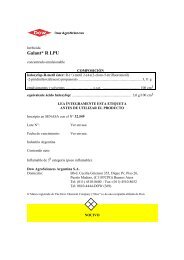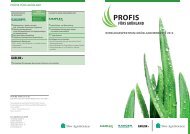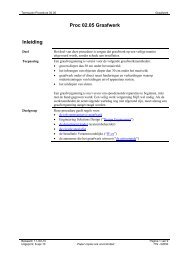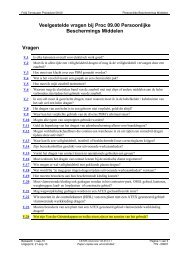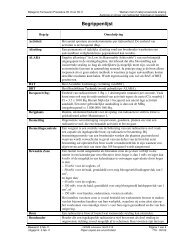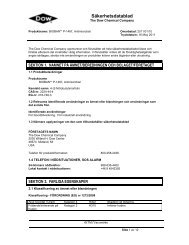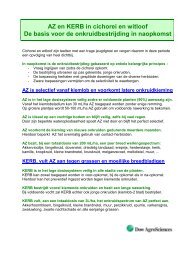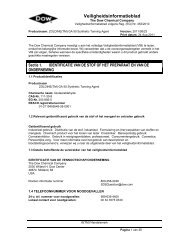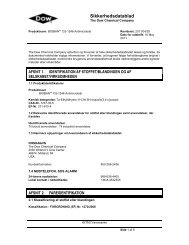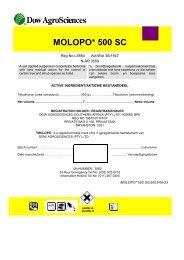Triethylene Glycol - The Dow Chemical Company
Triethylene Glycol - The Dow Chemical Company
Triethylene Glycol - The Dow Chemical Company
Create successful ePaper yourself
Turn your PDF publications into a flip-book with our unique Google optimized e-Paper software.
<strong>Triethylene</strong> <strong>Glycol</strong>
Table of<br />
Contents<br />
Introduction 1<br />
Quality, Service, and Product Information . . . . . . . . . . . . . . . . . . . . . 1<br />
Table 1 Applications . . . . . . . . . . . . . . . . . . . . . . . . . . . . . . 2<br />
Product Stewardship Guidelines and Principles . . . . . . . . . . . . . . . . . . 3<br />
Non-supported applications of <strong>Dow</strong>-manufactured EG, DEG,TEG,TETRA,<br />
and By-Products of <strong>Glycol</strong> Manufacturing . . . . . . . . . . . . . . . . . . . . 3<br />
Properties 5<br />
Table 2 Physical Properties of <strong>Triethylene</strong> <strong>Glycol</strong> . . . . . . . . . . . . . . . 5<br />
Table 3 Solubilities of Various Materials in <strong>Triethylene</strong> <strong>Glycol</strong> . . . . . . . . 6<br />
Table 4 <strong>Triethylene</strong> <strong>Glycol</strong> Compatibility with Elastomeric Materials . . . . . 7<br />
Table 5 Constant Boiling Mixtures of <strong>Triethylene</strong> <strong>Glycol</strong> . . . . . . . . . . . 8<br />
Figure 1 Freezing Points of Aqueous <strong>Triethylene</strong> <strong>Glycol</strong> Solutions . . . . . . . 9<br />
Figure 2 Boiling Points vs . Composition of Aqueous <strong>Triethylene</strong><br />
<strong>Glycol</strong> Solutions at Various Pressures . . . . . . . . . . . . . . . . 10<br />
Figure 3 Condensation Temperatures vs . Composition of Aqueous<br />
<strong>Triethylene</strong> <strong>Glycol</strong> Solutions at Various Pressures . . . . . . . . . . 11<br />
Figure 4 Vapor Pressures of <strong>Triethylene</strong> <strong>Glycol</strong> at Various Temperatures . . 12<br />
Figure 5 Vapor Pressures of Aqueous <strong>Triethylene</strong> <strong>Glycol</strong> Solutions at<br />
Various Temperatures . . . . . . . . . . . . . . . . . . . . . . . . 13<br />
Figure 6 Specific Gravities of Aqueous <strong>Triethylene</strong> <strong>Glycol</strong> Solutions . . . . . 14<br />
Figure 7 Viscosities of Aqueous <strong>Triethylene</strong> <strong>Glycol</strong> Solutions . . . . . . . . . 15<br />
Figure 8 Specific Heats of Aqueous <strong>Triethylene</strong> <strong>Glycol</strong> Solutions . . . . . . . 16<br />
Figure 9 <strong>The</strong>rmal Conductivities of Aqueous <strong>Triethylene</strong><br />
<strong>Glycol</strong> Solutions . . . . . . . . . . . . . . . . . . . . . . . . . . . 17<br />
Figure 10 Dew Points of Aqueous <strong>Triethylene</strong> <strong>Glycol</strong> Solutions at<br />
Various Contact Temperatures . . . . . . . . . . . . . . . . . . . 18<br />
Figure 11 Comparative Hygroscopicities of Various <strong>Glycol</strong>s<br />
at 70°F (21°C) . . . . . . . . . . . . . . . . . . . . . . . . . . . . 19<br />
Figure 12 Refractive Indices of Pure <strong>Triethylene</strong> <strong>Glycol</strong> . . . . . . . . . . . . 20<br />
i
Table of<br />
Contents<br />
Figure 13 Refractive Indices of Aqueous <strong>Triethylene</strong> <strong>Glycol</strong> Solutions<br />
at 77°F (25°C) . . . . . . . . . . . . . . . . . . . . . . . . . . . . 21<br />
Figure 14 Surface Tensions of Pure <strong>Triethylene</strong> <strong>Glycol</strong> . . . . . . . . . . . . . 22<br />
Figure 15 Surface Tensions of Aqueous <strong>Triethylene</strong> <strong>Glycol</strong> Solutions<br />
at 77°F (25°C) . . . . . . . . . . . . . . . . . . . . . . . . . . . . 23<br />
Figure 16 Electrical Conductivities of Aqueous <strong>Triethylene</strong><br />
<strong>Glycol</strong> Solutions . . . . . . . . . . . . . . . . . . . . . . . . . . . 24<br />
Health and Environmental Information 25<br />
Health Effects . . . . . . . . . . . . . . . . . . . . . . . . . . . . . . . . . . 25<br />
Environmental Information . . . . . . . . . . . . . . . . . . . . . . . . . . . 25<br />
Biodegradation . . . . . . . . . . . . . . . . . . . . . . . . . . . . . . . . . 25<br />
Storage and Handling 26<br />
Shipping Data . . . . . . . . . . . . . . . . . . . . . . . . . . . . . . . . . . 26<br />
Product Safety 27<br />
Emergency Service 28<br />
Sales Office 29<br />
ii
Introduction<br />
Precautions:<br />
Carefully review our current Material Safety<br />
Data Sheet<br />
<strong>Dow</strong>: Your Best Source<br />
for <strong>Triethylene</strong> <strong>Glycol</strong> Quality<br />
<strong>Dow</strong> is the world’s largest producer of<br />
ethylene oxide and glycols, with over 70<br />
years of experience in their manufacture,<br />
marketing, and research and development .<br />
<strong>The</strong> uniform implementation of statistical<br />
process control at all of our plants enables<br />
us to consistently deliver the high-quality<br />
product you require . Our total approach to<br />
Quality and Quality Systems is continuously<br />
improved to ensure that our facilities meet<br />
the requirements for registration to the<br />
stringent ISO 9000 series of standards .<br />
Optimum performance demands a quality<br />
product, and that is what we deliver . Our<br />
vast distribution system of plants, terminals,<br />
tankers, barges, tank cars, and trucks helps<br />
to ensure your delivery of triethylene glycol<br />
when and where you need it .<br />
Service<br />
For solutions to problems or answers to<br />
questions, <strong>Dow</strong> offers extensive technical<br />
service and support, available through trained<br />
sales representatives as well as our skilled<br />
staff from the Research and Development<br />
Department . Your order of triethylene glycol<br />
will be processed expertly and quickly when<br />
you place a call to one of our many helpful<br />
customer service representatives . (See page 29 .)<br />
1<br />
Product Information<br />
Formula C 6 H 14 O 4<br />
Molecular Formula HOCH 2 CH 2 OCH 2 CH 2 OCH 2 CH 2 OH<br />
CAS Number 112-27-6<br />
Synonyms <strong>Glycol</strong>-bis(hydroxyethyl) ether<br />
2,2’-[1,2-ethanediylbis(oxy)] bis-ethanol<br />
Triglycol<br />
TEG<br />
T3EG<br />
TriEG<br />
<strong>Triethylene</strong> glycol is a transparent, colorless,<br />
low-volatility, moderate-viscosity, watersoluble<br />
liquid . Under normal conditions,<br />
there is no detectable odor; under high vapor<br />
concentrations, a slightly sweet odor may be<br />
detected . It is completely miscible with water<br />
and many organic liquids . <strong>Triethylene</strong> glycol<br />
has properties similar to other glycols and<br />
may be used preferentially in applications<br />
requiring a higher boiling point, higher<br />
molecular weight, or lower volatility than<br />
diethylene glycol .<br />
<strong>The</strong> hydroxyl groups on triethylene glycol<br />
undergo the usual alcohol chemistry giving<br />
a wide variety of possible derivatives .<br />
Hydroxyls can be converted to aldehydes,<br />
alkyl halides, amines, azides, carboxylic<br />
acids, ethers, mercaptans, nitrate esters,<br />
nitriles, nitrite esters, organic esters, peroxides,<br />
phosphate esters and sulfate esters .<br />
<strong>Triethylene</strong> glycol may be used directly as a<br />
plasticizer or modified by esterification . <strong>The</strong><br />
solubility properties of triethylene glycol are<br />
important for many applications . End-uses<br />
for triethylene glycol are numerous . (See<br />
Table 1 .)<br />
Introduction
Introduction<br />
Table 1<br />
Applications<br />
Hygroscopicity • Dehydration of natural gas<br />
Plasticizer • Safety glass<br />
Low Volatility • Gas dehydration<br />
• Moisturizing and plasticizing cork, adhesives<br />
• Separation membranes (silicone rubber,<br />
polyvinyl acetate, cellulose triacetate)<br />
• Ceramic materials (resistant refractory<br />
plastics, molded ceramics)<br />
Solvent • Resin impregnants and other additives<br />
• Steam-set printing inks<br />
• Aromatic and paraffinic hydrocarbons separations<br />
• Cleaning compounds<br />
• Polyethylene terephthalate production equipment<br />
cleaning<br />
• Cyanoacrylate and polyacrylonitrile<br />
<strong>Chemical</strong> Intermediate • Unsaturated polyester resin<br />
• Various resins of the alkyd type used<br />
as laminating agents in adhesives<br />
• Esterification products used in plasticizer<br />
intermediates for nitrocellulose lacquers<br />
and vinyl resins<br />
• Polyester polyols for polyurethanes<br />
• <strong>The</strong>rmoplastic polyurethanes<br />
• Silcone compounds<br />
• Emulsifiers<br />
• Lubricants<br />
Freezing Point Depression • Heat transfer fluids<br />
2<br />
Introduction
Introduction<br />
Product Stewardship<br />
Guidelines and Principles of<br />
<strong>The</strong> <strong>Dow</strong> <strong>Chemical</strong> <strong>Company</strong><br />
<strong>The</strong> following bullet points identify some<br />
applications that are NOT supported by<br />
<strong>Dow</strong> for EG Products on a go-forward basis .<br />
<strong>The</strong> reasons for these limitations include<br />
areas in which we have decided not to<br />
pursue for general business reasons and<br />
actions that would minimize unnecessary<br />
risk and liabilities to the business . In addition,<br />
the following list of uses not supported by<br />
<strong>Dow</strong> does not imply a <strong>Dow</strong> warranty or <strong>Dow</strong><br />
support of uses in applications not covered<br />
by this list . This list is not all-inclusive .<br />
Non-supported applications of <strong>Dow</strong>-<br />
manufactured EG, DEG,TEG,TETRA, and<br />
By-Products of <strong>Glycol</strong> Manufacturing<br />
(<strong>Dow</strong> EG Products):<br />
• <strong>The</strong> use of <strong>Dow</strong> EG Products in the<br />
production of tobacco and in the manufacture<br />
of tobacco products (including<br />
but not limited to additives, humectants,<br />
filters, inks, and paper) is not supported<br />
by <strong>Dow</strong> .<br />
• <strong>The</strong> use of <strong>Dow</strong> EG Products for the<br />
generation of artificial smoke/theatrical<br />
fogs/mist is not supported by <strong>Dow</strong> .<br />
• <strong>The</strong> use of <strong>Dow</strong> EG Products as an<br />
ingredient in fuel for warming foods<br />
(Sterno TM -like application) or in fuel for<br />
heating an enclosed space where human<br />
exposure is possible is not supported<br />
by <strong>Dow</strong> .<br />
3<br />
• <strong>The</strong> use of <strong>Dow</strong> EG Products in fire<br />
extinguishing sprinkler systems is not<br />
supported by <strong>Dow</strong> .<br />
• <strong>The</strong> use of <strong>Dow</strong> EG Products in the<br />
manufacture of munitions is not supported<br />
by <strong>Dow</strong> .<br />
• <strong>The</strong> use of <strong>Dow</strong> EG Products in the<br />
production of deicers for use on roadways<br />
and pedestrian walkways is not supported<br />
by <strong>Dow</strong> .<br />
• <strong>The</strong> use of <strong>Dow</strong> EG Products as a component<br />
of heat transfer fluids in systems where the<br />
heat transfer fluid could infiltrate (e .g ., via<br />
an exchanger leak, backflow prevention<br />
failure, or other means) a potable water<br />
system is not supported by <strong>Dow</strong> .<br />
• <strong>The</strong> use of <strong>Dow</strong> EG Products purposely as<br />
a non-reacted component in a formulation<br />
for direct internal or external human/<br />
animal contact, including but not limited<br />
to ingestion, inhalation, and skin contact,<br />
and in medical/veterinary devices and<br />
medical/veterinary applications is not<br />
supported by <strong>Dow</strong> . (Examples of some such<br />
applications are uses as a direct component<br />
in foods, beverages, pharmaceuticals, cosme-<br />
tics, or personal care products .)<br />
• <strong>The</strong> use of <strong>Dow</strong> EG Products for consumer<br />
or hospital deodorizing or air “purifying”<br />
purposes by spraying as an aerosol is not<br />
supported by <strong>Dow</strong> .<br />
• <strong>The</strong> use of <strong>Dow</strong> EG Products as a<br />
non-reacted component in adhesives,<br />
packaging that has direct contact with<br />
food or beverages is not supported by <strong>Dow</strong> .<br />
Introduction
Introduction<br />
• <strong>The</strong> use of <strong>Dow</strong> EG Products as a nonreacted<br />
component in the formulation<br />
of glues, pastes, or items where the<br />
potential for sufficient human contact<br />
and/or ingestions exists (including but<br />
not limited to children’s school glues/<br />
paste or art/craft glue/paste) is not<br />
supported by <strong>Dow</strong> .<br />
To enter into new applications beyond<br />
the traditional standard industrial use<br />
applications, contact your <strong>Dow</strong> representative<br />
to review the specific application . <strong>Dow</strong> has<br />
a risk assessment process whereby the<br />
application will be reviewed and a determination<br />
will be made as to whether the<br />
application meets <strong>Dow</strong>’s requirements and<br />
can therefore be supported by <strong>Dow</strong> . Because<br />
use conditions and applicable laws may<br />
differ from one location to another and<br />
may change with time, when an application<br />
is supported by <strong>Dow</strong>, <strong>Dow</strong> does not warrant<br />
and is not responsible for the use in such<br />
application .<br />
4<br />
NO WARRANTIES ARE GIVEN;<br />
ALL IMPLIED WARRANTIES OF<br />
MERCHANTABILITY OR FITNESS<br />
FOR A PARTICULAR PURPOSE ARE<br />
EXPRESSLY EXCLUDED .<br />
Further, any violation of or failure to<br />
comply with the information contained in<br />
<strong>Dow</strong>’s Material Safety Data Sheet, Product<br />
Label, Product Information Guide, product<br />
literature or other product safety information<br />
is a misuse of <strong>Dow</strong>’s EG and Higher <strong>Glycol</strong><br />
Products . <strong>The</strong>se documents can be obtained<br />
by contacting your <strong>Dow</strong> representative or<br />
<strong>Dow</strong>’s Customer Information Group<br />
(800) 447-4369 . We can never specify all<br />
circumstances where misuse might occur,<br />
so if at any time a customer or downstream<br />
use appears to be improper or unsafe, please<br />
contact our Product Steward at (225) 353-6122 .<br />
Introduction
Properties<br />
Table 2<br />
Physical Properties of <strong>Triethylene</strong> <strong>Glycol</strong><br />
Determined on purified samples of <strong>Triethylene</strong> <strong>Glycol</strong><br />
Property Scientific Units Common Units<br />
Autoignition Temperature 349°C 660°F<br />
Boiling Point at 760 mm Hg 288 0°C 550 4°F<br />
∆ Boiling Point/∆ Pressure (750–770 mm Hg) 0 0073°C/kPa 0 055°C/mm Hg<br />
Critical Pressure 3,313 3 kPa 24,852 mm Hg<br />
Critical Specific Volume 0 443 L/gmol 7 10 ft 3 /lbmol<br />
Critical Temperature 440°C 824°F<br />
Dielectric Constant 23 69 23 69<br />
Electrical Conductivity 0 20 x 10 -6 mhos/cm 0 002 micromhos/cm<br />
Evaporation Rate (Butyl Acetate = 1)
Properties<br />
Table 3<br />
Solubilities of Various Materials in <strong>Triethylene</strong> <strong>Glycol</strong><br />
Solubility, g/100 mL of <strong>Triethylene</strong> <strong>Glycol</strong> at 25°C<br />
Material Solubility<br />
Acetone Completely Soluble<br />
Animal Glue (Dry) Slightly Soluble<br />
Benzene Completely Soluble<br />
Carbon Tetrachloride 40 6<br />
Castor Oil 0 3<br />
Cellulose Acetate Completely Soluble<br />
Chlorobenzene Completely Soluble<br />
Coconut Oil Insoluble<br />
Cottonseed Oil Insoluble<br />
Dextrin Completely Soluble<br />
Dextrin (10% in water) Insoluble<br />
Dibutyl Phthalate 19 8<br />
Dichloroethyl Ether Completely Soluble<br />
Diethanolamine Completely Soluble<br />
Ethyl Ether 20 4<br />
Ethylene <strong>Glycol</strong> Stearate Slightly Soluble<br />
Gum Damar Slightly Soluble<br />
Heptane Slightly Soluble<br />
Hydrous Wool Fat Slightly Soluble<br />
Kauri Gum Slightly Soluble<br />
Lard Oil Insoluble<br />
Linseed Oil Insoluble<br />
Methanol Completely Soluble<br />
Monoethanolamine Completely Soluble<br />
Nitrocellulose Completely Soluble<br />
o-Dichlorobenzene Completely Soluble<br />
Olive Oil Insoluble<br />
6<br />
Material Solubility<br />
Paraffin Oil Insoluble<br />
Phenol Completely Soluble<br />
Pine Oil Completely Soluble<br />
Rosin 5 0<br />
Shellac Slightly Soluble<br />
Soy Bean Oil Insoluble<br />
Sperm Oil Insoluble<br />
Tall Oil 10 1<br />
Tetrachloroethylene 17 7<br />
Toluene 33 0<br />
Tung Oil Insoluble<br />
Turkey Red Oil 12 3<br />
Urea 31 0<br />
Properties
Properties<br />
Table 4<br />
<strong>Triethylene</strong> <strong>Glycol</strong> Compatibility with Elastomeric Materials<br />
Material<br />
25˚C (77˚F) 80˚C (176˚F) 160˚C (320˚F)<br />
Adiprene L-100 Good Poor Poor<br />
Black Rubber 3773 Good Poor Poor<br />
Buna N (or 25) Good Good<br />
Buna S Good Fair Poor<br />
Butyl Rubber Good Good<br />
Compressed Asbestos Good Good Fair<br />
EPDM Good Good Good<br />
EPR Rubber Good Good Good<br />
Hycar D-24 Good Fair<br />
Hypalon Good Poor Poor<br />
Kalrez Good Good Good<br />
Natural Rubber Gum Good Poor Poor<br />
Neoprene 7797 Good Fair<br />
Red Rubber Number 107 Good Poor Poor<br />
Saraloy 300 Good Poor Poor<br />
Silicone No 65 Good Good<br />
Thiokol 3060 Good Poor Poor<br />
Viton A Good Good Poor<br />
7<br />
Temperature<br />
Properties
Properties<br />
Table 5<br />
Constant Boiling Mixtures of <strong>Triethylene</strong> <strong>Glycol</strong><br />
<strong>Triethylene</strong> <strong>Glycol</strong><br />
Acenaphthene<br />
<strong>Triethylene</strong> <strong>Glycol</strong> (5 mm Hg)<br />
Benzyl Ether<br />
<strong>Triethylene</strong> <strong>Glycol</strong><br />
Benzyl Phenyl Ether<br />
<strong>Triethylene</strong> <strong>Glycol</strong><br />
Biphenyl<br />
<strong>Triethylene</strong> <strong>Glycol</strong> (3 mm Hg)<br />
Diethylene <strong>Glycol</strong><br />
<strong>Triethylene</strong> <strong>Glycol</strong><br />
Diphenylmethane<br />
<strong>Triethylene</strong> <strong>Glycol</strong><br />
1,2-Diphenylmethane<br />
<strong>Triethylene</strong> <strong>Glycol</strong><br />
Ethyl Phthalate<br />
<strong>Triethylene</strong> <strong>Glycol</strong><br />
Isoamyl Benzoate<br />
<strong>Triethylene</strong> <strong>Glycol</strong><br />
Isoamyl Oxalate<br />
<strong>Triethylene</strong> <strong>Glycol</strong><br />
Isoamyl Salicylate<br />
<strong>Triethylene</strong> <strong>Glycol</strong><br />
Methyl Phthalate<br />
<strong>Triethylene</strong> <strong>Glycol</strong><br />
Phenyl Benzoate<br />
<strong>Triethylene</strong> <strong>Glycol</strong><br />
Phenyl Ether<br />
<strong>Triethylene</strong> <strong>Glycol</strong> (4 mm Hg)<br />
Phenyl Ether<br />
<strong>Triethylene</strong> <strong>Glycol</strong><br />
Water<br />
<strong>Triethylene</strong> <strong>Glycol</strong> (10 mm Hg)<br />
Water<br />
Components Azeotrope<br />
Specific<br />
Gravity<br />
at<br />
20/20°C<br />
1 1255 288 0<br />
277 9<br />
8<br />
In<br />
Azeotrope<br />
271 5 35<br />
65<br />
1 1255 145 5 (a) Azeo (a) 28<br />
72<br />
1 1255 288 0<br />
286 5<br />
1 1255 288 0<br />
256 1<br />
1 1255<br />
1 1184<br />
135 3 (a)<br />
108 0 (a)<br />
1 1255 288 0<br />
263 0<br />
1 1255 288 0<br />
284 5<br />
1 1255 288 0<br />
298 5<br />
1 1255 288 0<br />
262 0<br />
1 1255 288 0<br />
268 0<br />
1 1255 288 0<br />
277 5<br />
1 1255 288 0<br />
283 2<br />
1 1255 288 0<br />
315 0<br />
1 1255<br />
1 0677 (b)<br />
1 1255<br />
1 0677 (b)<br />
1 1255<br />
1 0000<br />
1 1255<br />
1 0000<br />
Boiling Point<br />
at<br />
760 mm Hg,<br />
0°C<br />
288 0<br />
259 0<br />
141 0 (a)<br />
102 0 (a)<br />
288 0<br />
100 0<br />
161 0 (a)<br />
11 0 (a)<br />
Boiling Point<br />
at<br />
760 mm Hg,<br />
0°C<br />
280 0 40<br />
60<br />
None<br />
None (a)<br />
263 0 20<br />
60<br />
275 5 42<br />
58<br />
In<br />
Upper<br />
Layer<br />
(c)<br />
(c)<br />
15<br />
85<br />
(c)<br />
(c)<br />
(c)<br />
(c)<br />
(c)<br />
(c)<br />
In<br />
Lower<br />
Layer<br />
(c)<br />
(c)<br />
60<br />
40<br />
(c)<br />
(c)<br />
(c)<br />
(c)<br />
(c)<br />
(c)<br />
(c)<br />
(c)<br />
U 72<br />
L 28<br />
< 285 5 > 58 (c) (c) (c)<br />
261 4 14<br />
86<br />
Reacts<br />
269 0 30<br />
70<br />
277 0 33<br />
67<br />
286 0 80<br />
20<br />
258 7 3<br />
97<br />
None (a)<br />
None<br />
None (a)<br />
(a) At the pressure investigated; (b) At 30/20°C; (c) Data not available<br />
Composition % by Wt at 20°C<br />
(c)<br />
(c)<br />
(c)<br />
(c)<br />
(c)<br />
(c)<br />
(c)<br />
(c)<br />
(c)<br />
(c)<br />
(c)<br />
(c)<br />
(c)<br />
(c)<br />
(c)<br />
(c)<br />
(c)<br />
(c)<br />
(c)<br />
(c)<br />
Relative<br />
Volume<br />
of<br />
Layers At<br />
20°C, %<br />
(c)<br />
(c)<br />
(c)<br />
(c)<br />
(c)<br />
(c)<br />
(c)<br />
(c)<br />
(c)<br />
(c)<br />
(c)<br />
(c)<br />
(c)<br />
(c)<br />
(c)<br />
(c)<br />
Properties
Properties<br />
Figure 1: Freezing Points of<br />
Aqueous <strong>Triethylene</strong> <strong>Glycol</strong> Solutions<br />
Figure 1<br />
Freezing Points of Aqueous <strong>Triethylene</strong> <strong>Glycol</strong> Solutions<br />
Temperature, °C<br />
10<br />
0<br />
-10<br />
-20<br />
-30<br />
-40<br />
-50<br />
0 10 20 30 40 50 60 70 80 90 100<br />
<strong>Triethylene</strong> <strong>Glycol</strong>, Percent by Weight in Water<br />
9<br />
50<br />
40<br />
30<br />
20<br />
10<br />
0<br />
-10<br />
-20<br />
-30<br />
-40<br />
-50<br />
-60<br />
Temperature, °F<br />
Properties
Properties<br />
Figure 2: Boiling Points vs. Composition of<br />
Aqueous Figure <strong>Triethylene</strong> 2 <strong>Glycol</strong> Solutions at Various Pressures<br />
Boiling Points vs Composition of Aqueous <strong>Triethylene</strong><br />
<strong>Glycol</strong> Solutions at Various Pressures<br />
Temperature, °C<br />
350<br />
300<br />
250<br />
200<br />
150<br />
100<br />
50<br />
1520 mm Hg*<br />
760 mm Hg<br />
300 mm Hg<br />
0 10 20 30 40 50 60 70 80 90 100<br />
<strong>Triethylene</strong> <strong>Glycol</strong>, Percent by Weight in Water<br />
*2 atmospheres absolute, 1 atmosphere gauge<br />
*2 atmospheres absolute, 1 atmosphere gauge<br />
10<br />
660<br />
620<br />
580<br />
540<br />
500<br />
460<br />
420<br />
380<br />
340<br />
300<br />
260<br />
220<br />
180<br />
140<br />
Temperature, °F<br />
Properties
Properties<br />
Figure 3: Condensation Temperatures vs. Composition of<br />
Aqueous <strong>Triethylene</strong> <strong>Glycol</strong> Solutions at Various Pressures<br />
Figure 3<br />
Condensation Temperatures vs Composition of Aqueous <strong>Triethylene</strong><br />
<strong>Glycol</strong> Solutions at Various Pressures<br />
Temperature, °C<br />
350<br />
300<br />
250<br />
200<br />
150<br />
100<br />
50<br />
1520 mm H g *<br />
760 mm Hg<br />
300 mm Hg<br />
0 10 20 30 40 50 60 70 80 90 100<br />
<strong>Triethylene</strong> <strong>Glycol</strong>, Percent by Weight in Water<br />
*2 atmospheres absolute, 1 atmosphere gauge<br />
*2 atmospheres absolute, 1 atmosphere gauge<br />
11<br />
660<br />
620<br />
580<br />
540<br />
500<br />
460<br />
420<br />
380<br />
340<br />
300<br />
260<br />
220<br />
180<br />
140<br />
Temperature, °F<br />
Properties
Properties<br />
Figure 4: Vapor Pressures of <strong>Triethylene</strong> <strong>Glycol</strong><br />
at Various Temperatures<br />
Figure 4<br />
Vapor Pressures of <strong>Triethylene</strong> <strong>Glycol</strong> at Various Temperatures<br />
Vapor Pressure, mm Hg<br />
1000<br />
800<br />
600<br />
400<br />
300<br />
200<br />
100<br />
80<br />
60<br />
40<br />
30<br />
20<br />
10<br />
8<br />
6<br />
4<br />
3<br />
2<br />
Temperature, °F<br />
220 240 280 320 360 400 440 480 560 640<br />
1<br />
100 120 140 160 180 200 240 280 320 360<br />
Temperature, °C<br />
<strong>Triethylene</strong> <strong>Glycol</strong> Antoine Constants for Calculating Vapor Pressure<br />
<strong>Triethylene</strong> <strong>Glycol</strong> Antoine Constants for Calculating Vapor Pressure<br />
3-Constant Equation (Temperature Range = 150–300°C)<br />
3-Constant Equation A = 7 (Temperature 6302007 Range = 150 - 300°C) Range = 150–300°C<br />
A=<br />
7.<br />
63B<br />
0=<br />
22156<br />
00<br />
74581<br />
P = mm RHg<br />
ange<br />
= 150<br />
- 30<br />
0°<br />
C<br />
B=<br />
215<br />
6C<br />
. = 4165<br />
58192442<br />
T = °C P = mm<br />
H g<br />
Log (P) = A – B/(T + C)<br />
C = 165<br />
. 9210<br />
44<br />
2<br />
T = ° C<br />
Log 5-Constant 10 (P) = A – B/(T Equation + C) (Temperature Range = 360 15–712 51°K)<br />
A = 95 5205 Range = 360 15–712 51°K<br />
5-Constant Equation (Temperature Range = 360.15 - 712.51°K)<br />
A=<br />
95<br />
. 52<br />
05<br />
R ange<br />
= 36<br />
0.<br />
15<br />
- 712<br />
. 51K<br />
B=<br />
12<br />
83<br />
4.<br />
7<br />
P = Pa<br />
C = 0.<br />
0<br />
T = K elvin<br />
D = -9.6 6752<br />
E=3.0015 x 10 -29<br />
N=10<br />
ln(P) = A – B/(T + C) + D(ln(T)) + ET N<br />
B = 12834 7 P = Pa<br />
C = 0 0 T = Kelvin<br />
D = -9 66752<br />
E = 3 0015 x 10-29 N = 10<br />
ln(P) = A – B/(T + C) + D(ln(T)) + ETN 12<br />
<strong>Triethylene</strong> <strong>Glycol</strong><br />
Antoine Constants<br />
A = 7.6302007<br />
B = 2156.4581<br />
C = 165.92442<br />
Log(P) = A–B/(t+C)<br />
mm Hg, Log 10 , ˚C<br />
Properties
Properties<br />
Figure 5: Vapor Pressures of<br />
Aqueous <strong>Triethylene</strong> <strong>Glycol</strong> Solutions at Various Temperatures<br />
Figure 5<br />
Vapor Pressures of Aqueous <strong>Triethylene</strong> <strong>Glycol</strong> Solutions<br />
at Various Temperatures<br />
Vapor Presure, mm Hg<br />
<strong>Triethylene</strong> <strong>Glycol</strong> 3-Constant Antoine Antoine Constants Equation for LogCalculating (P) = A – B/(T + Vapor C)<br />
10 Pressure<br />
P = mm Hg, T = °C<br />
3-Constant Antoine Equation<br />
Log 10 (P) = A – B/(T + C)<br />
P = mm Hg, T = °C<br />
T riE<br />
G , W t%<br />
0<br />
50<br />
70<br />
80<br />
90<br />
95<br />
97<br />
98<br />
99<br />
99<br />
. 5<br />
100<br />
10,000<br />
6,000<br />
4,000<br />
2,000<br />
1,000<br />
600<br />
400<br />
200<br />
40<br />
60<br />
100<br />
4 6<br />
20<br />
10<br />
2<br />
1<br />
0.6<br />
0.4<br />
-40 -20 0 20 40<br />
Temperature, ˚F<br />
80 120 160 200 240 300<br />
Freezing Point<br />
Curves<br />
0.2<br />
0.1<br />
-40 -20 0 20 40 60 80 100 130 160<br />
Temperature, ˚C<br />
<strong>Triethylene</strong> <strong>Glycol</strong> Antoine Constants for Calculating Vapor Pressure<br />
TriEG, Wt% A B C<br />
0 7 959199 1663 545 227 575<br />
50 7 922294 1671 501 228 031<br />
70<br />
80 A<br />
7 878546<br />
7 837076<br />
1681 363<br />
1697 006 B<br />
228 237<br />
228 769<br />
90 7 726126 1728 047 229 823<br />
95 7 620215 1806 257 236 227<br />
97 7 495349 1841 522 238 048<br />
98 7 404435 1881 474 240 666<br />
99 7 211145 1926 114 242 799<br />
99 5 7 042989 1970 802 242 865<br />
100 7 472115 2022 898 152 573<br />
7.<br />
95<br />
919<br />
9<br />
7.<br />
92<br />
22<br />
94<br />
7.<br />
87<br />
85<br />
46<br />
7.<br />
837<br />
076<br />
7.<br />
72<br />
612<br />
6<br />
7.<br />
62<br />
0215<br />
7.<br />
49<br />
53<br />
49<br />
7.<br />
40<br />
44<br />
35<br />
7.<br />
21114<br />
5<br />
7.<br />
04<br />
29<br />
89<br />
7.<br />
47211<br />
5<br />
13<br />
166<br />
3.<br />
54<br />
5<br />
1671.<br />
501<br />
1681<br />
. 36<br />
3<br />
169<br />
7.<br />
00<br />
6<br />
172<br />
8.<br />
047<br />
180<br />
6.<br />
257<br />
1841.<br />
52<br />
2<br />
1881<br />
. 474<br />
192<br />
6.<br />
114<br />
197<br />
0.<br />
80<br />
2<br />
20<br />
22<br />
. 89<br />
8<br />
C<br />
0<br />
50<br />
70<br />
80<br />
90<br />
95<br />
97<br />
98<br />
99<br />
99.5<br />
100<br />
<strong>Triethylene</strong> <strong>Glycol</strong>, Percent by Weight in Water<br />
22<br />
7.<br />
575<br />
22<br />
8.<br />
031<br />
22<br />
8.<br />
237<br />
22<br />
8.<br />
769<br />
22<br />
9.<br />
82<br />
3<br />
23<br />
6.<br />
22<br />
7<br />
23<br />
8.<br />
04<br />
8<br />
24<br />
0.<br />
66<br />
6<br />
24<br />
2.<br />
79<br />
9<br />
24<br />
2.<br />
86<br />
5<br />
Properties<br />
152<br />
. 573
Properties<br />
Figure 6: Specific Gravities of Aqueous<br />
<strong>Triethylene</strong> <strong>Glycol</strong> Solutions<br />
Figure 6<br />
Specific Gravities of Aqueous <strong>Triethylene</strong> <strong>Glycol</strong> Solutions<br />
Specific Gravity at T/60°F = A + Bx + Cx 2<br />
x = Weight % <strong>Triethylene</strong> <strong>Glycol</strong><br />
T , ° F<br />
-5<br />
0<br />
0<br />
50<br />
100<br />
150<br />
20<br />
0<br />
25<br />
0<br />
30<br />
0<br />
Apparent Specific Gravity, T/60˚F<br />
1.18<br />
1.16<br />
1.14<br />
1.12<br />
1.10<br />
1.08<br />
1.06<br />
1.04<br />
1.02<br />
1.00<br />
0.98<br />
0.96<br />
0.94<br />
0.92<br />
0.90<br />
1.<br />
05<br />
02<br />
1.<br />
0319<br />
1.<br />
0121<br />
0.<br />
99<br />
20<br />
0.<br />
98<br />
04<br />
0.<br />
96<br />
27<br />
0.<br />
9413<br />
0.<br />
9177<br />
Freezing Point<br />
Curves-50˚F<br />
14<br />
1.<br />
82<br />
68<br />
E -3<br />
1.<br />
746<br />
6E<br />
-3<br />
1.<br />
5247<br />
E -3<br />
1.<br />
7518<br />
E -3<br />
1.<br />
5410<br />
E -3<br />
1.<br />
40<br />
68<br />
E -3<br />
1.<br />
32<br />
05<br />
E -3<br />
1.<br />
2511<br />
E -3<br />
0˚F<br />
50˚F<br />
100˚F<br />
150˚F<br />
200˚F<br />
250˚F<br />
300˚F<br />
0 10 20 30 40 50 60 70 80 90 100<br />
<strong>Triethylene</strong> <strong>Glycol</strong>, Percent by Weight in Water<br />
Specific Gravity at T/60°F = A + Bx + Cx 2<br />
x = Weight % <strong>Triethylene</strong> <strong>Glycol</strong><br />
T, °F A B C<br />
-50 1 0502 1 8268E-3 -5 2009E-6<br />
0<br />
50 A<br />
1 0319<br />
1 0121<br />
1 7466E-3<br />
1 5247E-3 B<br />
-4 8304E-6<br />
-2 8794E-6<br />
100 0 9920 1 7518E-3 -5 4955E-6<br />
150 0 9804 1 5410E-3 -4 3884E-6<br />
200 0 9627 1 4068E-3 -3 5089E-6<br />
250 0 9413 1 3205E-3 -2 7991E-6<br />
300 0 9177 1 2511E-3 -2 0848E-6<br />
C<br />
-5<br />
. 20<br />
09<br />
E -6<br />
-4<br />
. 83<br />
04<br />
E -6<br />
-2<br />
. 87<br />
94<br />
E -6<br />
-5<br />
. 49<br />
55<br />
E -6<br />
-4<br />
. 38<br />
84<br />
E -6<br />
-3<br />
. 50<br />
89<br />
E -6<br />
-2<br />
. 79<br />
91E<br />
-6<br />
-2<br />
. 08<br />
48<br />
E -6<br />
Properties
Properties<br />
Figure 7: Viscosities of<br />
Aqueous <strong>Triethylene</strong> <strong>Glycol</strong> Solutions<br />
Figure 7<br />
Viscosities of Aqueous <strong>Triethylene</strong> <strong>Glycol</strong> Solutions<br />
Viscosity, Centiposies (cP) = A x 10<br />
x = Weight % <strong>Triethylene</strong> <strong>Glycol</strong><br />
T, °F<br />
0<br />
A<br />
1 53010<br />
Bx<br />
B<br />
2 9967E-2<br />
50 1 09200 1 9348E-2<br />
100 0 58916 1 5763E-2<br />
150 0 37045 1 3481E-2<br />
200<br />
250<br />
300<br />
1.<br />
530<br />
0 27371 10<br />
1.<br />
090<br />
218759<br />
00<br />
0 14026<br />
1 1731E-2<br />
9 7064E-3<br />
8 1319E-3<br />
T, °F A B<br />
0<br />
50<br />
100<br />
150<br />
20<br />
0<br />
25<br />
0<br />
30<br />
0<br />
Viscosity, Centipoises<br />
1000<br />
600<br />
400<br />
200<br />
100<br />
60<br />
40<br />
20<br />
10<br />
6<br />
4<br />
2<br />
1<br />
0.6<br />
0.4<br />
0.2<br />
0.<br />
58<br />
916<br />
0.<br />
37<br />
04<br />
5<br />
0.<br />
27<br />
371<br />
0.<br />
187<br />
59<br />
0.<br />
140<br />
26<br />
Freezing Point<br />
Curves<br />
15<br />
2.<br />
99<br />
67E<br />
-2<br />
1.<br />
93<br />
48<br />
E -2<br />
1.<br />
576<br />
3E<br />
-2<br />
1.<br />
34<br />
81E<br />
-2<br />
1.<br />
1731<br />
E -2<br />
9.<br />
70<br />
64<br />
E -3<br />
8.<br />
1319<br />
E -3<br />
0˚F<br />
50˚F<br />
100˚F<br />
150˚F<br />
200˚F<br />
250˚F<br />
300˚F<br />
0.1<br />
0 10 20 30 40 50 60 70 80 90 100<br />
<strong>Triethylene</strong> <strong>Glycol</strong>, Percent by Weight in Water<br />
Viscosity, Centiposies (cP) = A x 10 Bx<br />
x = Weight % <strong>Triethylene</strong> <strong>Glycol</strong><br />
Properties
Properties<br />
Figure 8<br />
Specific Heats of Aqueous <strong>Triethylene</strong> <strong>Glycol</strong> Solutions<br />
Figure 8: Specific Heats of<br />
Aqueous <strong>Triethylene</strong> <strong>Glycol</strong> Solutions<br />
Specific Heat = A + BT+CT 2<br />
T = Temperature, °C<br />
T riE<br />
G , W t%<br />
0<br />
10<br />
20<br />
30<br />
40<br />
50<br />
60<br />
70<br />
80<br />
90<br />
100<br />
Specific Heat, Btu/lb/˚F<br />
1.1<br />
1.0<br />
0.9<br />
0.8<br />
0.7<br />
0.6<br />
0.5<br />
Temperature, ˚F<br />
-40 0 40 80 120 160 200 240 280 320 360<br />
Freezing Point<br />
Curves<br />
0.4<br />
-50 0 50 100 150 200<br />
Temperature, ˚C<br />
Specific Heat = A + BT+CT2 T = Temperature, °C<br />
TriEG, Wt% A B C<br />
0 1 00540 -2 7286E-4 2 9143E-6<br />
10 A 0 96705 -2 7144E-5 B 2 4952E-6<br />
20 0 92490 2 0429E-4 2 4524E-6<br />
30 0 88012 4 3000E-4 1 6952E-6<br />
40 0 83229 6 2286E-4 1 3714E-6<br />
50 0 78229 7 9286E-4 1 0857E-6<br />
60 0 72200 9 4000E-4 8 0000E-7<br />
70 0 66688 1 0871E-3 4 7620E-7<br />
80 0 60393 1 2043E-3 2 8571E-7<br />
90 0 53888 1 2800E-3 1 9048E-7<br />
100 0 48614 1 3929E-3 -5 7140E-8<br />
1.<br />
00<br />
54<br />
0<br />
0.<br />
967<br />
05<br />
0.<br />
924<br />
90<br />
0.<br />
88<br />
012<br />
0.<br />
83<br />
22<br />
9<br />
0.<br />
78<br />
22<br />
9<br />
0.<br />
72<br />
20<br />
0<br />
0.<br />
66<br />
68<br />
8<br />
0.<br />
60<br />
39<br />
3<br />
0.<br />
53<br />
88<br />
8<br />
0.<br />
48<br />
614<br />
16<br />
-2<br />
. 72<br />
86<br />
E -4<br />
-2<br />
. 7144<br />
E -5<br />
2.<br />
04<br />
29<br />
E -4<br />
4.<br />
30<br />
00<br />
E -4<br />
6.<br />
22<br />
86<br />
E -4<br />
7.<br />
92<br />
86<br />
E -4<br />
9.<br />
40<br />
00<br />
E -4<br />
1.<br />
08<br />
71E<br />
-3<br />
1.<br />
20<br />
43<br />
E -3<br />
1.<br />
28<br />
00<br />
E -3<br />
1.<br />
39<br />
29<br />
E -3<br />
C<br />
0<br />
20<br />
10<br />
30<br />
40<br />
50<br />
60<br />
70<br />
80<br />
90<br />
100<br />
2.<br />
9143<br />
E -6<br />
2.<br />
49<br />
52<br />
E -6<br />
2.<br />
45<br />
24<br />
E -6<br />
1.<br />
69<br />
52<br />
E -6<br />
1.<br />
3714<br />
E -6<br />
1.<br />
08<br />
57E<br />
-6<br />
8.<br />
00<br />
00<br />
E -7<br />
4.<br />
762<br />
0E<br />
-7<br />
2.<br />
8571<br />
E -7<br />
1.<br />
90<br />
48<br />
E -7<br />
-5<br />
. 7140<br />
E -8<br />
<strong>Triethylene</strong> <strong>Glycol</strong>, Percent by Weight in Water<br />
Properties
Properties<br />
Figure 9: <strong>The</strong>rmal Conductivities of<br />
Aqueous <strong>Triethylene</strong> <strong>Glycol</strong> Solutions<br />
Figure 9<br />
<strong>The</strong>rmal Conductivities of Aqueous <strong>Triethylene</strong> <strong>Glycol</strong> Solutions<br />
<strong>The</strong>rmal Conductivity = A + BT<br />
T = Temperature, °C<br />
TriEG, Wt% A B<br />
0<br />
10<br />
20<br />
30<br />
40<br />
50<br />
60<br />
70<br />
80<br />
90<br />
100<br />
<strong>The</strong>rmal Conductivity, Btu (ft)/hr (ft 2 ) ˚F<br />
0.45<br />
0.40<br />
0.35<br />
0.30<br />
0.25<br />
0.20<br />
0.15<br />
0.10<br />
Temperature, ˚F<br />
0 40 80 120 160 200 240 280 320 360<br />
Freezing Point<br />
Curves<br />
0.05<br />
-20 0 20 40 60 80 100 120 140 160 180 200<br />
Temperature, ˚C<br />
<strong>The</strong>rmal Conductivity = A + BT<br />
T = Temperature, °C<br />
TriEG, Wt% A B<br />
0 0 33667 7 1667E-4<br />
10 0 31000 6 0000E-4<br />
20 0 29000 4 0000E-4<br />
30 0 27200 2 0000E-4<br />
40 0 25133 3 3333E-5<br />
50 0 22767 3 3333E-5<br />
60 0 20933 -1 6667E-4<br />
70 0 18800 -2 0000E-4<br />
80 0 17267 -2 8333E-4<br />
90 0 15567 -2 8333E-4<br />
100 0 14133 -3 1667E-4<br />
0.<br />
33<br />
667<br />
0.<br />
3100<br />
0<br />
0.<br />
29<br />
00<br />
0<br />
0.<br />
27<br />
20<br />
0<br />
0.<br />
2513<br />
3<br />
0.<br />
22<br />
767<br />
0.<br />
20<br />
93<br />
3<br />
0.<br />
188<br />
00<br />
0.<br />
172<br />
67<br />
0.<br />
155<br />
67<br />
0.<br />
1413<br />
3<br />
17<br />
7.<br />
1667<br />
E -4<br />
6.<br />
00<br />
00<br />
E -4<br />
4.<br />
00<br />
00<br />
E -4<br />
2.<br />
00<br />
00<br />
E -4<br />
3.<br />
33<br />
33<br />
E -5<br />
3.<br />
33<br />
33<br />
E -5<br />
-1.<br />
66<br />
67E<br />
-4<br />
-2<br />
. 00<br />
00<br />
E -4<br />
-2<br />
. 83<br />
33<br />
E -4<br />
-2<br />
. 83<br />
33<br />
E -4<br />
-3<br />
. 1667<br />
E -4<br />
0<br />
10<br />
20<br />
30<br />
40<br />
50<br />
60<br />
70<br />
80<br />
90<br />
100<br />
<strong>Triethylene</strong> <strong>Glycol</strong>, Percent by Weight in Water<br />
Properties
Properties<br />
Figure 10<br />
Dew Points of Aqueous <strong>Triethylene</strong> <strong>Glycol</strong> Solutions at<br />
Various Contact Temperatures<br />
Figure 10: Dew Points of Aqueous <strong>Triethylene</strong> <strong>Glycol</strong> Solutions at<br />
Various Contact Temperatures<br />
Dew or Frost Point = A + BT<br />
T = Temperature, °C<br />
TriEG, Wt% 50 A -3 0308 1 01050 B<br />
50<br />
70<br />
80<br />
90<br />
95<br />
98<br />
99<br />
99<br />
. 5<br />
Frost Point, ˚C Dew Point, ˚C<br />
60<br />
50<br />
40<br />
30<br />
20<br />
10<br />
0<br />
-10<br />
-20<br />
-30<br />
-40<br />
Contact Temperatures of Solution, ˚F<br />
-20 0 20 40 60 80 100 120<br />
Freezing Point<br />
Curves<br />
-50<br />
-30 -20 -10 0 10 20 30 40 50<br />
Contact Temperatures of Solution, ˚C<br />
Dew or Frost Point = A + BT<br />
T = Temperature, °C<br />
TriEG, Wt% A B<br />
70 -7 0009 1 01610<br />
80 -10 745 1 01160<br />
90 -17 923 0 98187<br />
95 -25 252 0 93019<br />
98 -34 675 0 85598<br />
99 -41 419 0 80150<br />
99 5 -47 195 0 73263<br />
-3<br />
. 03<br />
08<br />
-7.<br />
00<br />
09<br />
-10<br />
. 745<br />
-17.<br />
92<br />
3<br />
-2<br />
5.<br />
25<br />
2<br />
-3<br />
4.<br />
675<br />
-41.<br />
419<br />
-47.<br />
195<br />
18<br />
<strong>Triethylene</strong> <strong>Glycol</strong>,<br />
Percent by Weight<br />
in Water<br />
50<br />
70<br />
1.<br />
010<br />
50<br />
1.<br />
01610<br />
1.<br />
0116<br />
0<br />
0.<br />
9818<br />
7<br />
0.<br />
93<br />
019<br />
0.<br />
85<br />
59<br />
8<br />
0.<br />
8015<br />
0<br />
0.<br />
73<br />
26<br />
3<br />
80<br />
90<br />
95<br />
98<br />
99<br />
99.5<br />
140<br />
130<br />
120<br />
110<br />
100<br />
90<br />
80<br />
70<br />
60<br />
50<br />
40<br />
30<br />
20<br />
10<br />
0<br />
-10<br />
-20<br />
-30<br />
-40<br />
-50<br />
Frost Point, ˚F Dew Point, ˚F<br />
Properties
Properties<br />
Figure 11: Comparative Hygroscopicities of<br />
Various Figure <strong>Glycol</strong>s 11 at 70°F (21°C)<br />
Comparative Hygroscopicities of Various <strong>Glycol</strong>s at 70°F (21°C)<br />
Percent Water (Based on Dry Humectant at Equilibrium)<br />
100<br />
80<br />
70<br />
60<br />
50<br />
40<br />
30<br />
20<br />
10<br />
8<br />
7<br />
6<br />
Propylene <strong>Glycol</strong><br />
Diethylene <strong>Glycol</strong><br />
<strong>Triethylene</strong> <strong>Glycol</strong><br />
5<br />
25 30 35 40 45 50 55 60 65 70 75<br />
Percent Relative Humidity<br />
19<br />
Ethylene <strong>Glycol</strong><br />
Dipropylene <strong>Glycol</strong><br />
Properties
Properties<br />
Figure 12: Refractive Indices of<br />
Pure <strong>Triethylene</strong> <strong>Glycol</strong><br />
Figure 12<br />
Refractive Indices of Pure <strong>Triethylene</strong> <strong>Glycol</strong><br />
Reactive Index<br />
1.460<br />
1.458<br />
1.456<br />
1.454<br />
1.452<br />
1.450<br />
1.448<br />
1.446<br />
20 22 24 26 28 30 32 34 36 38 40<br />
Temperature, ˚C<br />
Refractive Index = 1 4626 – 0 000340T<br />
Refractive<br />
T = Temperature,<br />
Index =<br />
°C<br />
1.4626 – 0.000340T<br />
T = Temperature, °C<br />
20<br />
Properties
Properties<br />
Figure 13: Refractive Indices of<br />
Aqueous Figure <strong>Triethylene</strong> 13 <strong>Glycol</strong> Solutions at 77°F (25°C)<br />
Refractive Indices of Aqueous <strong>Triethylene</strong> <strong>Glycol</strong> Solutions at 77°F (25°C)<br />
Reactive Index<br />
1.50<br />
1.48<br />
1.46<br />
1.44<br />
1.42<br />
1.40<br />
1.38<br />
1.36<br />
1.34<br />
1.32<br />
1.30<br />
0 10 20 30 40 50 60 70 80 90 100<br />
<strong>Triethylene</strong> <strong>Glycol</strong>, Percent by Weight in Water<br />
Refractive<br />
Refractive<br />
Index,<br />
Index, 77°F<br />
77°F<br />
(25°C)<br />
(25°C)<br />
= 1<br />
1.3326<br />
3326 +<br />
+<br />
0<br />
0.0012403<br />
0012403 x<br />
x<br />
x<br />
=<br />
Weight<br />
Weight % <strong>Triethylene</strong><br />
<strong>Triethylene</strong><br />
<strong>Glycol</strong><br />
<strong>Glycol</strong><br />
21<br />
Properties
Properties<br />
Figure 14: Surface Tensions of<br />
Pure <strong>Triethylene</strong> <strong>Glycol</strong><br />
Figure 14<br />
Surface Tensions of Pure <strong>Triethylene</strong> <strong>Glycol</strong><br />
Surface Tension, dynes/cm<br />
46<br />
44<br />
42<br />
40<br />
38<br />
36<br />
40 80 120 160 200 240 280<br />
34<br />
0 50<br />
Temperature, ˚F<br />
Temperature, ˚C<br />
Surface Tension, dynes/cm = 47 330 – 0 088T<br />
Surface Tension, dynes/cm = 47.330 – 0.088T<br />
T = Temperature, °C<br />
T = Temperature, °C<br />
22<br />
100 150<br />
Properties
Properties<br />
Figure 15: Surface Tensions of<br />
Aqueous <strong>Triethylene</strong> <strong>Glycol</strong> Solutions at 77°F (25°C)<br />
Figure 15<br />
Surface Tensions of Aqueous <strong>Triethylene</strong> <strong>Glycol</strong> Solutions at 77°F (25°C)<br />
Surface Tension, dynes/cm<br />
80<br />
70<br />
60<br />
50<br />
40<br />
30<br />
0 10 20 30 40 50 60 70 80 90 100<br />
<strong>Triethylene</strong> <strong>Glycol</strong>, Percent by Weight in Water<br />
23<br />
Properties
Properties<br />
Figure 16: Electrical Conductivities of<br />
Aqueous <strong>Triethylene</strong> <strong>Glycol</strong> Solutions<br />
Figure 16<br />
Electrical Conductivities of Aqueous <strong>Triethylene</strong> <strong>Glycol</strong> Solutions<br />
Electrical Conductivity, micromhoms/cm<br />
12<br />
10<br />
8<br />
6<br />
4<br />
2<br />
0<br />
0 10 20 30 40 50 60 70 80 90 100<br />
<strong>Triethylene</strong> <strong>Glycol</strong>, Percent by Weight in Water<br />
Note: <strong>The</strong> quality of the water used for dilution can significantly affect<br />
Note: <strong>The</strong> quality of water used for dilution can significantly affect<br />
the electrical conductivity<br />
electrical conductivity.<br />
24<br />
Properties
Health and<br />
Environmental Information<br />
Health Effects<br />
See our current Material Safety Data Sheet<br />
for the most current exposure limits, health,<br />
first aid, and toxicology information .<br />
Environmental Information<br />
See our current Material Safety Data Sheet<br />
for current toxicity information .<br />
Biodegradation<br />
For information concerning the biodegradability<br />
of triethylene glycol, please refer to<br />
the latest Material Safety Data Sheet .<br />
25<br />
Health and Environmental Information
Storage and<br />
Handling<br />
This information is offered as a guide in<br />
planning bulk storage facilities for glycols .<br />
<strong>Glycol</strong>s are generally considered to be stable,<br />
noncorrosive chemicals with high flash<br />
points . Under ordinary conditions, all of<br />
these chemicals can be stored in mild steel<br />
vessels . For long-term storage, or if trace<br />
iron contamination and the development of<br />
color are objectionable in any of the glycols,<br />
a storage vessel lined with a baked-phenolic<br />
resin, an air-drying epoxy-phenolic resin, or<br />
a vinyl resin or a stainless steel or aluminum<br />
tank is suggested . Zinc or galvanized iron<br />
is not recommended, and copper or copper<br />
alloys may cause product discoloration .<br />
It is not general practice to use an inert gas<br />
in the vapor space of glycol storage tanks,<br />
because all chemicals in this family have<br />
high boiling points and the vapors in the<br />
tanks are relatively nonflammable . However,<br />
if extremely low water content is required,<br />
consistent with a long storage period, a<br />
nitrogen blanket can be used to exclude<br />
atmospheric moisture and air . Blanketing<br />
with nitrogen will also minimize low-level<br />
oxidation, if necessary for the desired<br />
application . <strong>The</strong> inert gas prevents air<br />
oxidation in order to maintain product<br />
within acidity specifications . Increased<br />
acidity enhances iron pickup from steel<br />
vessels . Alternatively, a desiccant unit can<br />
be installed on the tank vent line to dry<br />
incoming air .<br />
If above-ground outside storage is planned,<br />
it may be necessary to install provisions for<br />
heating tanks and lines . Many glycols have a<br />
26<br />
moderately high freezing point or become<br />
relatively viscous at severe winter temperatures<br />
. However, excessive temperature can<br />
cause undesirable degradation of glycols .<br />
Automatic controls are suggested to limit the<br />
temperature of the contents to 120°F (49°C) .<br />
In cold climates, it is generally desirable<br />
to make provisions for draining the pump<br />
and the transfer lines if they are outside<br />
the building . If this is not feasible, it may<br />
be necessary to insulate and steam trace or<br />
otherwise heat the transfer lines to prevent<br />
freezing of the product . Care must be taken<br />
in such an application, because continued<br />
exposure of glycols to high temperatures,<br />
greater than 120°F (49°C), will result in<br />
product degradation . Transfer piping of<br />
mild steel is generally used .<br />
Shipping Data<br />
<strong>Triethylene</strong> glycol is not regulated by the U .S .<br />
Department of Transportation; therefore,<br />
it does not have a DOT Shipping Name,<br />
Hazard Classification, DOT Warning Label,<br />
or Identification Number .<br />
Shipping Data For <strong>Triethylene</strong> <strong>Glycol</strong><br />
Weight per Gallon at 20°C 9 36 lb<br />
Coefficient of Expansion at 55°C 0 00072<br />
Flash Point, Pensky-Martens Closed Cup 350°F<br />
Net Contents and Type of Container<br />
1-Gallon Tin Can 9 0 lb<br />
5-Gallon DOT 17E, Pail 47 lb<br />
55-Gallon DOT 17E, Drum 522 lb<br />
Storage and Handling
Product Safety<br />
When considering the use of triethylene<br />
glycol in any particular application, review<br />
and understand our current Material Safety<br />
Data Sheet for the necessary safety and<br />
health information . For Material Safety<br />
Data Sheets and other product safety<br />
information on <strong>Dow</strong> products, contact <strong>The</strong><br />
<strong>Dow</strong> <strong>Chemical</strong> <strong>Company</strong> sales office nearest<br />
you . Before handling any products mentioned<br />
in this booklet, you should obtain the<br />
available product safety information from<br />
the suppliers of those products and take the<br />
necessary steps to comply with all precautions<br />
regarding the use of triethylene glycol .<br />
No chemical should be used as or in a food,<br />
drug, medical device, or cosmetic, or in a<br />
product process in which it may come in<br />
contact with a food, drug, medical device,<br />
or cosmetic until the user has determined the<br />
27<br />
suitability of the use . Because use conditions<br />
and applicable laws may differ from one<br />
location to another and may change with time,<br />
Customer is responsible for determining<br />
whether products and the information in this<br />
document are appropriate for Customer’s<br />
use and for ensuring that Customer’s workplace<br />
and disposal practices are in compliance<br />
with applicable laws and other governmental<br />
enactments .<br />
<strong>Dow</strong> requests that the customer read,<br />
understand, and comply with the information<br />
contained in this publication and the<br />
current Material Data Safety Sheet(s) . <strong>The</strong><br />
customer should furnish the information in<br />
this publication to its employees, contractors,<br />
and customers, or any other users of<br />
the product(s), and request that they do<br />
the same .<br />
Product Safety
Emergency Service<br />
<strong>The</strong> <strong>Dow</strong> <strong>Chemical</strong> <strong>Company</strong> maintains an around-the-clock emergency service for its<br />
products . <strong>The</strong> <strong>Chemical</strong> Manufacturers Association (CHEMTREC), Transportation<br />
Canada (CANUTEC), and the <strong>Chemical</strong> Emergency Agency Service maintain an<br />
around-the-clock emergency service for all chemical products .<br />
Mainland United States<br />
and Puerto Rico<br />
Alaska and Hawaii<br />
Canada<br />
Location <strong>Dow</strong> Products All <strong>Chemical</strong> Products<br />
Continental Europe, Middle East,<br />
North and Central Africa<br />
United Kingdom and Ireland<br />
Latin America, Asia/Pacific, South<br />
Africa and any other location,<br />
worldwide<br />
If you are at sea, radio U S Coast<br />
Guard, who can directly contact<br />
<strong>Dow</strong> HELP or CHEMTREC<br />
Phone <strong>Dow</strong> HELP:<br />
(800) 822-4357 (toll-free)<br />
Phone Mainland United States:<br />
(800) 822-4357 (toll-free)<br />
Phone <strong>Dow</strong>:<br />
(519) 339-3711 (collect)<br />
Phone:<br />
+31 115 694982<br />
Phone National <strong>Chemical</strong><br />
Emergency Center (Culham-UK):<br />
44-1553-761-251<br />
(44)(0) 1865-407-333<br />
Phone United States:<br />
(800) 822-4357 (toll-free)<br />
Phone <strong>Dow</strong> HELP:<br />
(800) 822-4357 (toll-free)<br />
DO NOT WAIT Phone if in doubt You will be referred to a specialist for advice<br />
28<br />
Phone CHEMTREC:<br />
(800) 424-9300 (toll-free)<br />
Phone CHEMTREC:<br />
(800) 424-9300 (toll-free)<br />
Phone CANUTEC:<br />
(613) 996-6666 (collect)<br />
Phone CHEMTREC<br />
(United States):<br />
(703) 527-3887 (collect)<br />
Phone CHEMTREC<br />
(United States):<br />
(703) 527-3887 (collect)<br />
Phone CHEMTREC:<br />
(703) 527-3887 (collect)<br />
Phone CHEMTREC:<br />
(800) 424-9300 (toll-free)<br />
Emergency Service
Sales Office<br />
For additional information, contact our<br />
customer service center:<br />
<strong>The</strong> <strong>Dow</strong> <strong>Chemical</strong> <strong>Company</strong><br />
2040 <strong>Dow</strong> Center<br />
Midland, MI 48674<br />
www dow com<br />
Phone: (800) 232-2436<br />
29<br />
Sales Office
NOTICE: No freedom from any patent owned by Seller or others is to be inferred Because use conditions and applicable laws may differ from one<br />
location to another and may change with time, Customer is responsible for determining whether products and the information in this document are<br />
appropriate for Customer’s use and for ensuring that Customer’s workplace and disposal practices are in compliance with applicable laws and<br />
other governmental enactments Seller assumes no obligation or liability for the information in this document NO WARRANTIES ARE GIVEN;<br />
ALL IMPLIED WARRANTIES OF MERCHANTABILITY OR FITNESS FOR A PARTICULAR PURPOSE ARE EXPRESSLY EXCLUDED<br />
Published February 2007 ®Trademark of <strong>The</strong> <strong>Dow</strong> <strong>Chemical</strong> <strong>Company</strong> (“<strong>Dow</strong>”) or an affiliated company of <strong>Dow</strong> Form No: XXX-0207X CRCG




